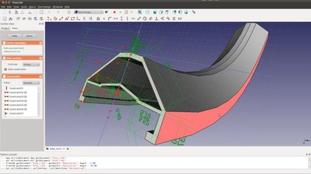
As I have alluded elsewhere, some tools are hard like saws, wrenches and hammers (yes, even the rubber mallet) and some tools are soft like softwear, i.e. programs that enhance our brainpower in the planning phase. Sometimes soft tools will be involve in the doing phase, but more on that later.
For planning, few programs beat a good 3d modelling software. We use them to see how our mental picture looks in real life before we build it. It can also help us work out problems, nail down specifics and share our ideas with others.
Commercial software is very expensive (thousands of dollars) and let's face it, we're not on that kind of budget. But fortunately, we still have options. There is a wide variety of free software out there for two main reasons: 1) Big software companies put out a boiled down version for free, like a trial. 2) Some smart people think great software should be free, so they work together to make it and give it away (opensource).
Each category has drawbacks: 1) Software companies want to make money, so their free stuff either has key components that are locked (like printing or even saving) or it is a limited time trial (often 30 day trial). 2) People who write programs for free can only do it in their spare time, so these programs tend to lag behind a little. Nonetheless, both can offer some very useful stuff for us and, hey, beggars can't be choosers. So we'll check out one of each.
Because I use Creo at work, I looked at their boiled down free package and it looks pretty decent. Not a whole lot of file manipulation capability, but it does look like it will export to .stl which is great for 3d printing. Also looks pretty user friendly. Great starter package for newbies. I haven't spent much time with it yet, but I will. Wanted to let you know, too, so you can check it out.
Even potentially better news! FreeCAD from SourceForge. This is from opensource folks who do this stuff out of their belief in free collaboration, not capital gain, so they won't lock up features and make you pay for them like big software companies. It looks like a parametric (feature based) which is cool and I also suspect they will have more features and even analysis (even FEA or CFD?) which is exciting for me, but maybe a little steeper learning curve for the uninitiated among us.
Well, I am one of those people doing this in my spare time (of which I am now out). So keep in touch! I'll get some more info up here as soon as I can.
Creo
http://www.ptc.com/products/creo-elements-direct/modeling-express/
FreeCAD
http://sourceforge.net/projects/free-cad/
More scintillating conversation @ http://www.chattlab.org/blog/group/
For planning, few programs beat a good 3d modelling software. We use them to see how our mental picture looks in real life before we build it. It can also help us work out problems, nail down specifics and share our ideas with others.
Commercial software is very expensive (thousands of dollars) and let's face it, we're not on that kind of budget. But fortunately, we still have options. There is a wide variety of free software out there for two main reasons: 1) Big software companies put out a boiled down version for free, like a trial. 2) Some smart people think great software should be free, so they work together to make it and give it away (opensource).
Each category has drawbacks: 1) Software companies want to make money, so their free stuff either has key components that are locked (like printing or even saving) or it is a limited time trial (often 30 day trial). 2) People who write programs for free can only do it in their spare time, so these programs tend to lag behind a little. Nonetheless, both can offer some very useful stuff for us and, hey, beggars can't be choosers. So we'll check out one of each.
Because I use Creo at work, I looked at their boiled down free package and it looks pretty decent. Not a whole lot of file manipulation capability, but it does look like it will export to .stl which is great for 3d printing. Also looks pretty user friendly. Great starter package for newbies. I haven't spent much time with it yet, but I will. Wanted to let you know, too, so you can check it out.
Even potentially better news! FreeCAD from SourceForge. This is from opensource folks who do this stuff out of their belief in free collaboration, not capital gain, so they won't lock up features and make you pay for them like big software companies. It looks like a parametric (feature based) which is cool and I also suspect they will have more features and even analysis (even FEA or CFD?) which is exciting for me, but maybe a little steeper learning curve for the uninitiated among us.
Well, I am one of those people doing this in my spare time (of which I am now out). So keep in touch! I'll get some more info up here as soon as I can.
Creo
http://www.ptc.com/products/creo-elements-direct/modeling-express/
FreeCAD
http://sourceforge.net/projects/free-cad/
More scintillating conversation @ http://www.chattlab.org/blog/group/

 RSS Feed
RSS Feed